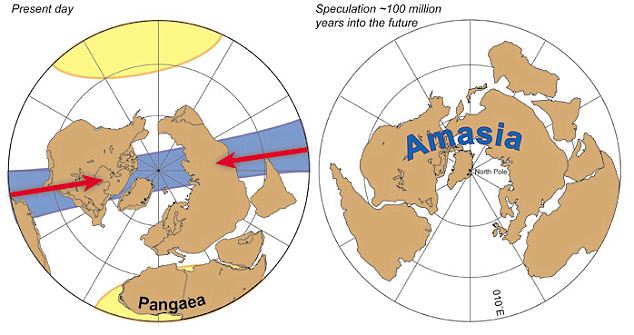
According to a study by Yale University scientists, the Earth will look very different in 200 million years, with the latest prediction that a supercontinent called Amasia will form right over the North Pole, and not over the centre of Africa, as previously thought.
North and South America will crunch together, with the Caribbean Sea and Arctic Ocean disappearing, while Asia will join the Americas, the scientists say.
“After those water bodies close, we’re on our way to the next supercontinent,” said lead researcher Ross Mitchell.
“You’d have the Americas meeting Eurasia practically at the North Pole.”
The results of the study were published this week in Nature, with the paper explaining that the formation of Amasia is between 50 and 200 million years away.
The Yale researchers used a process called orthoversion to arrive at their conclusions.

According to this, each succeeding supercontinent forms 90 degrees from the geographic centre of its ancient predecessor.
The new theory contrasts with the standard theories about supercontinent formation, introversion and extroversion, which hold that supercontinents form either 0 or 180 degrees away from the geographic centre of the previous supercontinent.
Under these earlier theories, the Atlantic Ocean will disappear and the next supercontinent will form with a centre more or less in the same spot as the last supercontinent’s centre, present-day Africa.
Alternately, the Pacific Ocean will disappear and the next supercontinent will form with a centre on the opposite side of the globe.
Ross Mitchell and colleagues arrived at the new theory after an extensive analysis of the magnetism of ancient rocks.
After each historical supercontinent assembled, it underwent a series of back-and-forth rotations around a stable axis along the equator.
From one supercontinent to the next, the axes were offset from each other by about 90 degrees, the Yale team showed – consistent with orthoversion, but not with either introversion or extroversion.
“This kind of analysis gives us a way to arrange continents in both latitude and longitude, providing a better understanding in patterns of biological dispersal and the dynamics of Earth’s deep interior,” said Yale doctoral student Taylor M. Kilian, the study’s second author.
The most recent supercontinent, Pangea (which is Greek for “All Lands”), formed about 300 million years ago with Africa at its centre.
Pangea began breaking apart into the seven continents of today with the birth of the Atlantic Ocean about 100 million years later.
Researchers believe Pangea is the third or fourth supercontinent in Earth’s history. Its immediate predecessors were Rodinia – which formed about 1 billion years ago – and Nuna, which formed about 1.8 billion years ago.
The idea of continental drift was introduced by German scientist Alfred Wegener in 1912, to explain how the shape of Earth’s countries looked suspiciously like jigsaw pieces that would fit together.
The Earth’s surface is formed from seven major and several minor tectonic plates that wander around at speeds varying from a few millimetres to two centimetres a year, the same pace that a human nail grows.
It’s the friction caused by plates grinding against each other that causes earthquakes.